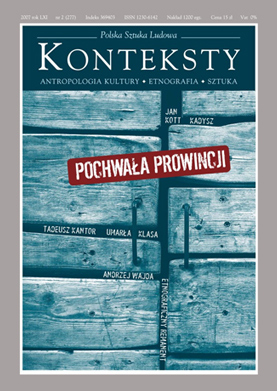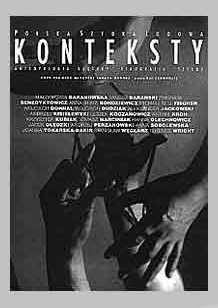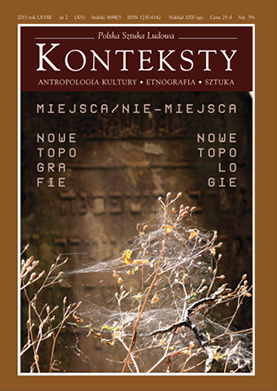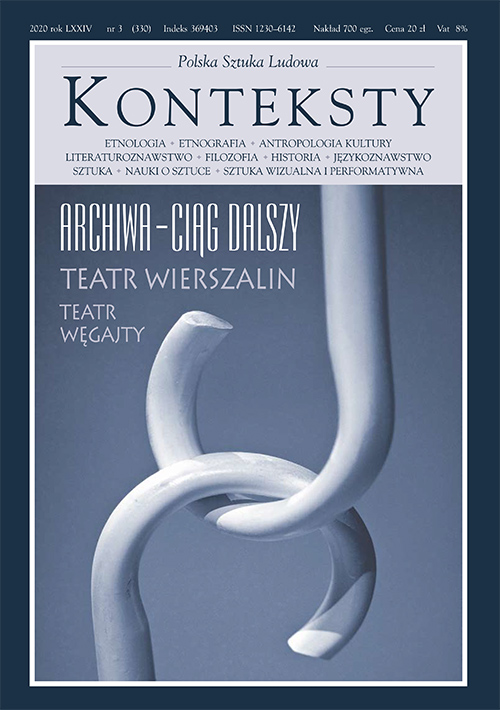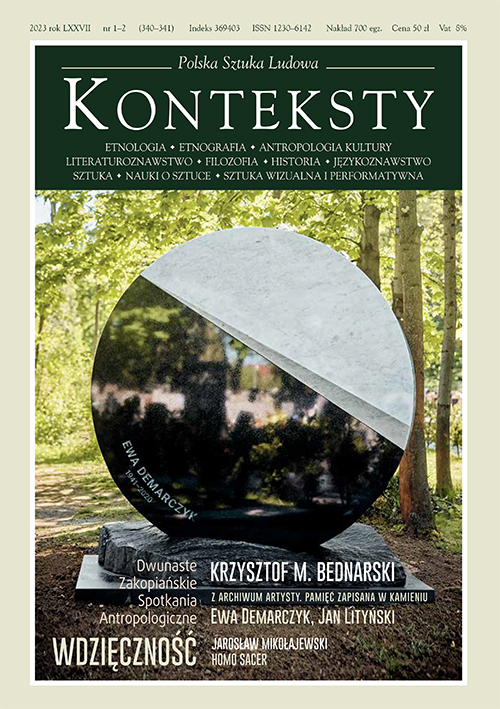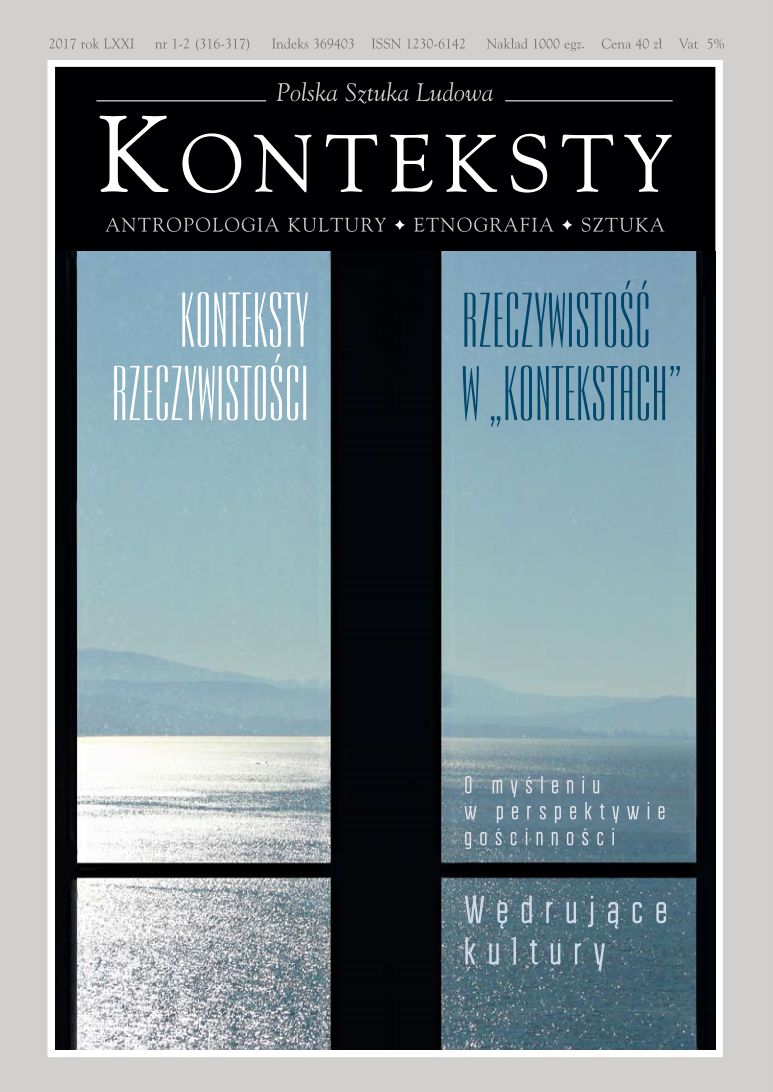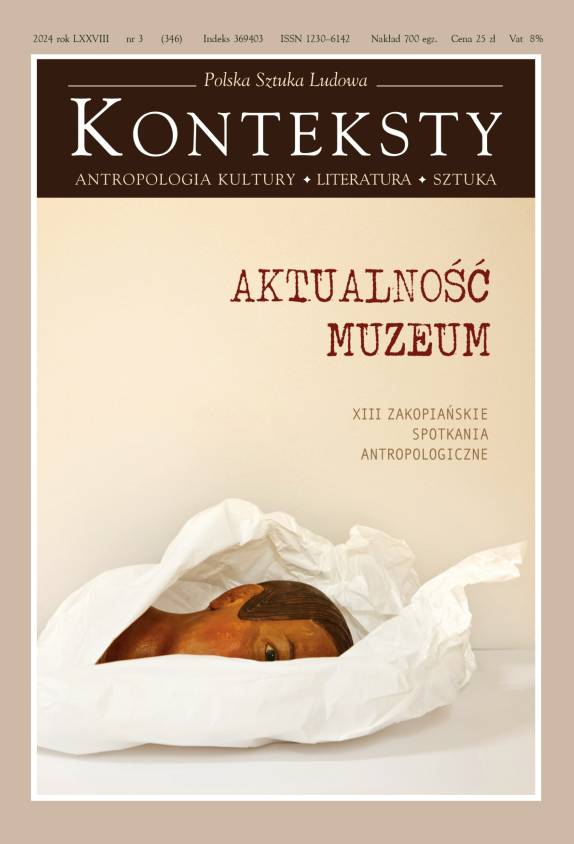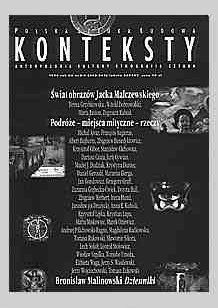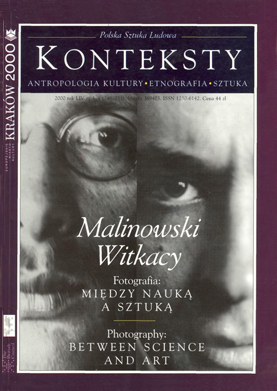Issue 2018/4 (323) - Image-story. The Archive of K. & M. Tchorek
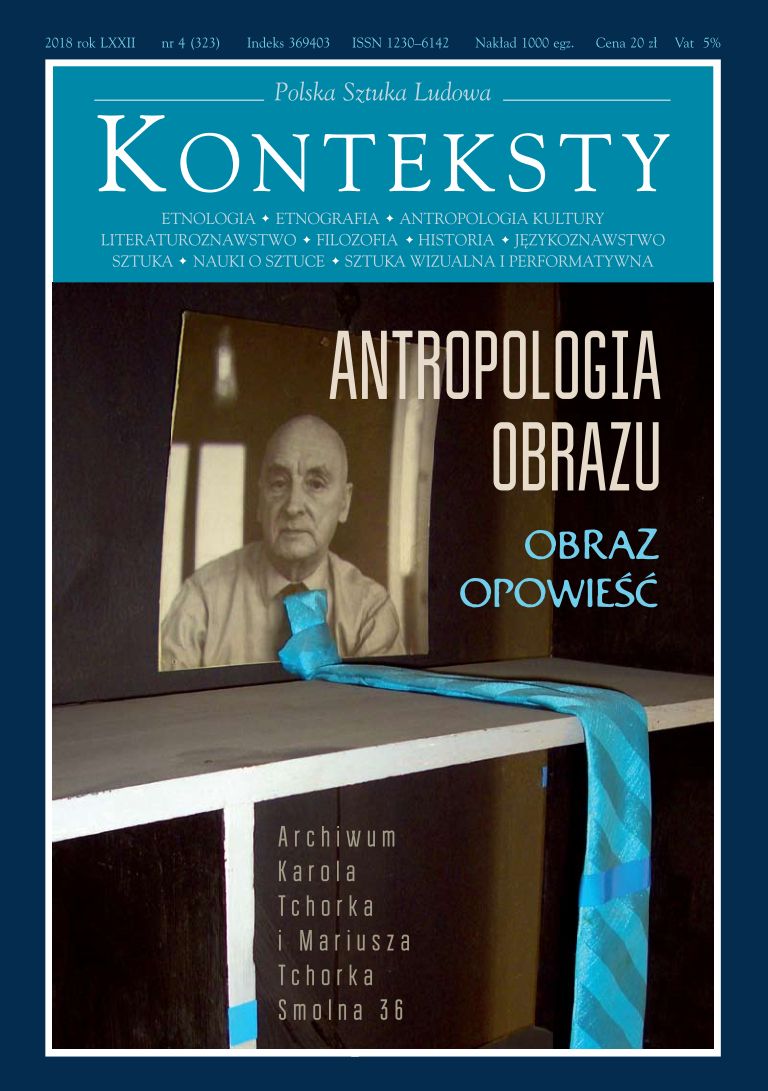
| Zofia Sokolewicz | Restore the Proper Name | 4 |
| Izabella Main, Elżbieta M. Goździak | Erasing Polish Anthropology?  | 5 |
| Image, Story | ||
| Wojciech Michera | Image, Story, Ghost Images  | 8 |
Many anthropologists of the image accentuate that visual images are treated as if they were subjects brought to life. By introducing in What Do Pictures Want? The Lives and Loves of Images the category of “wanting” W. J. T. Mitchell turns the “life“ of the image into a problem and indicates its, i.a. “ghostly” character. In the opinion of the author of this article Mitchell paid insufficient attention to the possibility of images wishing to deceive their recipients, towards whom they turn. By referring to the views of, i.a. J. Hillis Miller, Nicolas Abraham, Jacques Lacan, and Paul de Man Michera demonstrated that the interpretational “story” provoked by images is “apotropaic”, i.e. it comprises a “safe” solution, which, at the same time, conceals that, which would breach the subjective status of the recipient. The second part of the article is an analysis of two exemplary “metapictures”, which can be treated as an attempt at problematizing this problem: Albrecht Dürer’s drawing “Angels’ Mass” and Robert Walser’s “Micrograms”. | ||
| Piotr Gierowski | Word and Image in the Art of Outsiders  | 17 |
An attempted analysis of relations between the word and the image in the domain of outsider art or art brut. The author considered the manner in which elements of writings were applied in artistic compositions by selected authors (Władysław Grygny, Zdeněk Košek, Iwona Mysera), while at the same time drawing attention to assorted processes and transformations to which this medium succumbs in the described works and trying to indicate within this context features specific for this particular sphere of artistic activity. The methodological foundation of the study is composed of such conceptions as: the intentional and the non-intentional (Jan Mukařovský), the semiotic (Julia Kristeva), visuality (Georges Didi-Huberman), shapelessness, and ornament. | ||
| Andrzej Leśniak | Visual Art Thought. The Mediation of Technology in Art According to Pierre Francastel  | 25 |
Texts by Pierre Francastel, the French sociologist of art, are precursors of important contemporary models of thinking about art. Such ideas as art conceived as the place of thought, the expansion of the perception of art by including the anthropological dimension, and questioning the limits of art have become quite obvious. In accordance with the thesis proposed in this article these types of elements of a breakthrough in reflections on art (summed up in the article on the joint conceit of “visual art thought”) were devised by Francastel thanks to tackling the interpretation of relations between art and technology. The French sociologist wished to understand the way in which art, predominantly Modernism, makes it possible to understand technical progress and modernity as such. With this purpose in mind he questioned the limit of the discipline of history and postulated studies whose object were to be mutual relations between parallel developing cultural practices. | ||
| Kamila Morawska | All Elements of Narration, or the Literary Statement According to Gaston Bachelard  | 32 |
In his capacity as a “philosopher of poetry” Bachelard rehabilitated imagination and its images while intending to demonstrate the positive value of imagery in the poeticoneiric domain. He presented an original conception of literary creativity as a creative revival of the constant archetype/creative variation on the theme of the unchanging matrix for images. By making original use of the discoveries of psychoanalysis and phenomenology he proposed the conception of “archetypical images” and the “ontology of the imaginary”. More, thanks to the application of those methods he discovered the natural and dynamic contents of the image. As a result of those analyses it is possible to discover in Bachelardisme a definition of an image as a combination of the archetypical forms of the unconscious, which belong to the subject together with an already independent material substantiality of the perceived outer world (the symbolic of the four elements of Nature: fire, water, air, and earth). One should, however, not forget the subject – the “dreamer of words” (rêveur de mots) – who finalises the verbal-iconic process. His “novelty” (nouveauté) is of enormous significance as the one that synthesises the function of creative imagination. | ||
| Paweł Dybel | Images of the Petrification of the World and Death in the Pre-war Lyrics of Miłosz  | 41 |
The author of this essay proposed to decipher Miłosz’s prewar poetry from the viewpoint of the motifs of the petrification of the world as well as the passage of time and death. In doing so he described this current in Miłosz’s poetry as thanatic, indicating that it reveals concealed kinship with the late Freudian theory of drives, based on the opposition between Eros and Thanatos. This pessimistic tenor in Miłosz’s pre-war poetry is associated with emphasis on the finite dimension of human existence. Consequently, it was to be connected with recurring catastrophic motifs merged with pity for the world in the shape in which it is given to man. This is the reason why Miłosz’s poetry can be described as elegiac, mourning the inevitable departure of everything into death and nothingness. | ||
| Katarzyna Bojarska | Artistic Testimony – the Case of Otto Dov Kulka  | 50 |
A presentation of the features of artistic testimony and literal quality conceived as a vehicle of historical testimony, with particular attention paid to its cognitive and affective aspects. The successive part of the text proposes a detailed study of a single case - the “literary” book by Otto Dove Kulka, an historian of the Holocaust and anti-Semitism. K. Bojarska went on to indicate certain features of the analysed case and proposed an alternative formula of artistic testimony and of the witness as creator. | ||
| Paulina Kwiatkowska | Last Year in Marienbad as a Ciné-roman  | 60 |
Last Year in Marienbad appeared in 1961 almost simultaneously in two different forms – the film by Alain Resnais and the ciné-roman by Alain Robbe-Grillet issued by Les Éditions de Minuit. This article endeavours to bring the reader closer to the phenomenon of the ciné-roman as an obscure textual-visual form that enters into convoluted relations with assorted literary genres, on the one hand, and with ways of narrating and presentation characteristic for the cinema, on the other hand. The author is interested in the sources of the ciné-roman, which she perceives both in selected phenomena of inter-war mass-scale culture and in the theoretical and practical quests of the avant-garde. Another objective is an analysis of the text by Robbe-Grillet from the vantage point of the narrative strategies applied by him in the light of reflections concerning the nouveau roman and the theories of the cinematic and literary image. | ||
| Robert Birkholc | Double Perspective. Mediated Subjectivisation in the Film  | 68 |
This text is dedicated to a type of film subjectivisation, which the author described as mediated. In doing so he proposed the thesis that there exists a trans-media figure of depicting the experiences of the protagonists, which in literature is realised in the form of free indirect speech, and in the film – of mediated subjectivisation. The determinants of this figure are the subjectivisation of the message upon a stylistic level and overlapping perspectives (focalisation). In order to distinguish this narration from other ways of bringing closer the perspective of the protagonist the author distinguished three types of internal focalisation in the film – narrativization, personalisation, and subjectiviation. The characteristic feature of mediated subjectivisation is the fact that the manner in which the protagonist perceives reality is “marked” by such stylistic means as the non-standard points of view of the camera, lighting, staging, colours, montage or sound. The term: “mediated”, on the other hand, indicates that narration of this sort does not create the illusion of indirect access to the internal world of the protagonists but accentuates the mediation of a certain “higher” narration level in transmitting the internal states of the protagonists. The author characterised the functions of mediated subjectivisation and indicated the manner in which it serves the process of bringing out the experiences of the protagonist. | ||
| Agata Sierbińska | “Fist Bump” and Other Gestures. About a Photograph from Smolensk  | 78 |
On 10 April 2010 Donald Tusk and Vladimir Putin met on the site of the catastrophic crash of the Polish presidential plane. One of the photographs documenting this event appeared (three years later) on the cover of the “W Sieci” weekly. Its publication gave rise to an intense public debate concerning the gesture made by the Polish Prime Minister. The presented text is an analysis of the manner it functions in the social game taking place in the visual field; it is also an attempt at perceiving the stake of the exchange set into motion by this image. | ||
| Katarzyna Prokopowicz | #BreakingNews: Middle Eastern Conflicts in the Polish Media  | 90 |
The author studied the manner of depicting conflicts in the Middle East in articles published on Polish information portals in 2015-201; she also analysed photographs used in those articles and the contemporary technologies of portraying war. | ||
| Tchorek, Smolna 36 | ||
| Karol i Mariusz Tchorek's Archive | ||
| Marcin Krassowski | Who the Hell Was Mariusz Tchorek?  | 99 |
The article explains the origin of the idea of dedicating a fragment of “Konteksty” to Mariusz Tchorek – a partially forgotten versatile and prolific artist, whose oeuvre deserves to be recalled and rediscovered. The article contains an outline of the different domains pursued by Tchorek – from art criticism and psychology all the way to translations or philosophy – and sketches the structure of the part of the “Konteksty” issue about Tchorek composed of connected sub-chapters, each of which casts light on Mariusz from another perspective. The first part is about the Studio in Smolna Street – the place where Karol Tchorek worked and which was the object of Mariusz’s special concern. The second part presents the Mariusz Tchorek oeuvre from assorted stages of his life and domains: critical and theoretical texts and ones associated with the therapy he practised at the time he worked at the University of East Anglia. The last part includes theoretical and personal texts written by Mariusz’s acquaintances as well as researchers representing various disciplines, whose works are inspired by the Tchorek oeuvre or deal with it. An integral part of the issue contains material from the Mariusz Tchorek archive created by Katy Bentall, which, while preserving the configuration of archival boxes, is interwoven with other texts. | ||
| Katy Bentall | Introduction | 101 |
| Studio | ||
| Aleksander Jackowski | Letter | 102 |
| Agnieszka Chmielewska, Katarzyna Kucharska-Hornung | Struggles with Nike: the Karol Tchorek Art Salon  | 103 |
The basic framework of this article is a reconstruction of the Nike Art Salon (1943–1951), a modern art gallery and antique shop ran by Karol Tchorek, sculptor and father of Mariusz. The author presents a detailed history of the battles waged for the sake of obtaining, renovating, and preserving the shop in 63 Marszałkowska Street, problems with regaining artworks after the Warsaw Uprising and returning works given on commission at the time of the German occupation, as well as the commercial activity of Nike and its cooperation with assorted art institutions. The key context for writing the story of Nike was the attitude of Mariusz Tchorek towards his father’s activity. Although the history of the salon took place during his childhood it affected Mariusz’s whole life – the gathered historical objects cast a shadow on the relations between father and son. | ||
| Agnieszka Wagner | Memory Sites. Plaques and Monoliths by Karol Tchorek  | 115 |
Attempts at making inventories of, and documenting National Memory Sites, so characteristic for the iconosphere of Warsaw, have been undertaken upon numerous occasions. The outcome of those endeavours in correlation to the examined material in archival collections distinctly indicates gaps, errors, or restrictions of the range to photographic inventories or limiting the list to a concrete period (e.g. the Warsaw Uprising). The project presented by the author of this article produced a complete record and registration of plaques and monoliths designed by the sculptor Karol Tchorek and commemorating the history of the town during the tragic events of the last war. The accumulated material basis: photographic documentation, assessment of the technical state, and an orderly arrangement of data upon the basis of archival documents will, hopefully, enable a graphic study and the issuing of a publication – a map of Warsaw showing the background of events in the form of a guidebook to Memory Sites. The documentation and outcome of the project were entrusted to the Tchorek-Bentall Foundation, which, in accordance with its Statute, is the guardian of the artistic bequest of Karol Tchorek. | ||
| Piotr Jerzy Leśniak | A Threatened Object. On the Studio, Subjectivity, and Spatial Planning  | 121 |
A view of the interior of a sculptor’s studio in 36 Smolna Street in Warsaw – one of the Places of Mariusz Tchorek (1939–2004), created by his father, Karol Tchorek (1905–1985). By combining a description of the architecture of the interior of the historical studio and an outline of its town-planning-institutional exterior, the article attempts to cast light on the threat of utilitarianism, which the studio resists. | ||
| Laura Waniek | Remarks about 36 Smolna Street  | 132 |
This text about the historical Karol Tchorek Studio in 36 Smolna Street in Warsaw is an attempt at gathering fundamental information from the viewpoint of the Studio’s unclear ontological status, historical character, and uncertain future. The first aspect is associated with its origin, multi-motif nature, and history, which the author has been tackling for years as caretaker, cleaning lady, archivist, and friend of the family. The text thus divides its attention between history, culture, architecture, and management. In order to outline the context it broadens the perspective by including the area directly adjoining the Studio. It also contains quotations from the famous Wprowadzenie do ogólnej Teorii Miejsca and indicates connections between Mariusz Tchorek’s Theory of the Place and the special nature of the discussed place. | ||
| Magdalena Stopa | Place. 36 Smolna Street  | 138 |
Karol Tchorek died in 1985. His son, Mariusz, acclaimed art critic and co-founder of the Foksal Gallery passed away 19 years later. In 36 Smolna Street they left behind a study brimming with artworks. Today, it remains under the care of Katy Bentall, born in London, the daughter-in-law of Karol Tchorek, who actually never got to know him. After the death of her husband in 2004 she did not return to the United Kingdom, changed all life plans, and decided to remain in Warsaw on a permanent basis - far from her family, with two small children, and without speaking Polish. She was not intimidated by the ruined ground-floor studio, unsettled ownership issues, and a neighbourhood of ill repute. | ||
| Marcin Krassowski | A Sketch about Divisions and Boxes  | 141 |
A reflection on the phenomenon of the archive, and in particular the archive of Mariusz Tchorek, as well as a report on the selection of visual material for “Konteksty”. From the very onset of work on the issue it was obvious that visual material should originate from the archive in Smolna Street in Warsaw. The place of the archive amongst other material was just as apparent as was the manner of arranging the objects so as to preserve both their visual aspect and textual stratum. Reflection binds musings on the archive and the diaries. In both cases editing work and reprints could result in losing the visual stratum of the original and accentuate the textual quality. Another aspect of the conducted reflections is the structure of the archive’s presentation. With the parallel between the archive and a diary or a journal as the point of departure archival material is to be reprinted in accordance with the arrangement of the archive boxes – counterparts of folios or the chapters of diaries or novels. | ||
| Kamil Julian | Biographical note Mariusz Tchorek 1939–2004 | 146 |
| Texts by Mariusz Tchorek | ||
| Mariusz Tchorek | On the Usage of New Possibilities of Matter  | 149 |
A block of texts, reviews, lectures, and papers on art, artists, and psychotherapy conducted by Mariusz Tchorek, presented in 1950–2000 in “Struktury” – a periodical dedicated to art, and at sessions held at, i.a. the Museum of Art in Łódź, the Centre of Contemporary Art Ujazdowski Castle in Warsaw, and many others. | ||
| Mariusz Tchorek | On the Search of the Third Dimension | 151 |
| Mariusz Tchorek | The Necessary and Possible Image | 157 |
| Mariusz Tchorek | Witkacy and Strzemiński Attempt at Mediation | 161 |
| Wiesław Borowski, Hanna Ptaszkowska, Mariusz Tchorek | The Theory of Place | 165 |
| Mariusz Tchorek | The Disclosed Picture | 167 |
| Mariusz Tchorek | Anonima in Warsaw | 170 |
| Mariusz Tchorek | On Edward Krasiński | 171 |
| Mariusz Tchorek | Interactions | 173 |
| Mariusz Tchorek | Power and Relation. Authority and Development | 174 |
| Mariusz Tchorek | Glimpses for one owns life | 176 |
| Mariusz Tchorek | On Mystery | 178 |
| Mariusz Tchorek | Once Again on the Natural and Supranatural Facts of Painting, or On the Body of the Artist | 186 |
| Mariusz Tchorek | On Henryk Stażewski | 191 |
| Mariusz Tchorek | On Mewa, or Filled with Otherness | 194 |
| Mariusz Tchorek | The Place of Birth, the Birth of the Place | 199 |
| Texts about Mariusz Tchorek | ||
| Henryk Waniek | My Sketch to the Second Part of an Essay about the Painting “Mercury, Jupiter and Virtue” by Dosso Dossi Tagged Canvas, Written in 1965 by Mariusz Tchorek 1939–2004  | 203 |
Assorted reminiscence after the death of Mariusz Tchorek included a recurring question of his text about a painting by D. Dossi in the Wawel Castle collections, which he wrote and published in prints issued by the Foksal Gallery at the very onset of the latter’s existence. The text in question produced the impression of a superficially and outlined brief sketch, a fact of which Tchorek was well aware – he intended to prepare a suitably in-depth version in the vague future, even more so since in time his awareness of the multistrata symbolic of the Dossi painting expanded. For certain reason the project remained more a topic of conversations or written declarations. As far as I know it was never finalized. This essay attempts (in a certain sense light-heartedly) to help him with this design. Naturally, this is a futile attempt since suddenly the number of issues connected with Mariusz Tchorek turns out to be inexhaustible. | ||
| Henryk Waniek | In Walecznych Street and Smolna Street  | 213 |
The pretext to this sprinkling of reminiscences is Mariusz Tchorek’s long-lasting fascination with the poetry of Bolesław Leśmian and its ambivalent “mysticism”. Ultimately, this collection of facts, presented without superfluous details, might be recognised as an attempt at rendering precise the rather unconventional and magnetic personality of a friend. | ||
| Henryk Waniek | Beginning End, and Between Attempted Memories  | 216 |
In this case reminiscences linked with the beginning of my friendship with Mariusz Tchorek concentrate on the evolution of the vantage point from which he perceived the reality of art. This evolution was a process strongly inspiring for the co-participants and witnesses of his activity. I saw it as a moulded by diametrically different geographical-cultural and social relations and am, therefore, compelled to present accounts of this impact in my capacity as someone who recognises in Tchorek’s ideas his status as a mentor. | ||
| Anka Ptaszkowska | On Mariusz Tchorek  | 221 |
Mariusz Tchorek is portrayed predominantly by his rare texts. We constantly accused him of writing too little. The merit of his scarce texts lies in the fact that they were necessary at their time (but also today). What a relief and what a commitment in comparison with the mass of ordinarily unnecessary texts. | ||
| Elizabeth De Bievre | Tea in Bowthorpe, or Mariusz’s Architecture  | 223 |
Impressions about the life of Mariusz Tchorek in Norwich, as seen by his friend. | ||
| Magda Tchorek-Bentall | *** | 225 |
| Edyta Barucka | Notes and Images. Correspondence with Katy Bentall  | 226 |
I met Katy Bentall in 2007 in Warsaw, at a dinner given upon the occasion of the arrival of Richard Demarco, an accomplished collector of Polish art. I talked with him about the Little Sparta garden of Ian Hamilton Finlay and his visit at the studio in 36 Smolna Street. “you simply must see that place”, he said at the end of the evening and his determined voice became the reason why several months later I phoned Katy Bentall with a request to view the studio. That meeting became the beginning of our acquaintance and numerous conversations, which slowly disclosed the past of this spot, permeated with images and reminiscences, and the story of its successive users, including the collector and sculptor Karol Tchorek, his son Mariusz Tchorek, and Katy, who after Mariusz’s death took care of the legacy of her father-in-law and husband while executing her own works at the studio. It is difficult to briefly describe the vastness and diversity of the valuable archival collections over which she assumed custody and which I was able to freely examine and browse through – canvases and books, letters and sketchbooks, plaster models and photographs, some of which are described and reproduced in this publication. The images, emotions, and recollections that emerged in the course of successive meetings remained more intangible. When I asked myself what I would like to write about for “Konteksty” I thought that it would be a good thing to return to that ephemeral substance of our conversations and to recall some of those contents as much as possible, in a tête-à-tête with Katy. Since we were unable to conduct such a talk personally this text ultimately emerged from our e-mail correspondence from 19 July to 7 September 2017. | ||
| Katy Bentall | Living among Paintings by Edward Narkiewicz  | 236 |
This is a collage of thoughts about Edward Narkiewicz, collected from my notes and fragments of a diary written in the course of several years and originally combined and recorded on tracing paper for “Edward Narkiewicz from the collection of Mariusz Tchorek”, an event that took place upon the occasion of the Long Night of Museums at the studio in Smolna Street (May 2017). | ||
| Paweł Polit | Mariusz Tchorek’s Conception of the Place in the Contexts of Unism and Phenomenological Aesthetics  | 240 |
The text sets out to describe the origin and development of Mariusz Tchorek’s conception of the place coined in response to post-war developments in abstract painting – Henryk Stażewski’s late version of Constructivism, on the one hand, and the informel type of painting, on the other hand. Other points of reference were Katarzyna Kobro’s and Władysław Strzeminski’s programme of Unism and Roman Ingarden’s theory of painting; the article shows the way in which Tchorek’s conception of the place connects the ontological aspect of a Unist work with the notion of intentionality developed in Ingarden’s aesthetics. In addition, it highlights the performative dimension of Tchorek’s theoretical reflection. | ||
| Agata Jakubowska | Katy Bentall and the Studio  | 251 |
A text dedicated to the activity of Katy Bentall – an artist born and educated in England – pursued in 36 Smolna Street in Warsaw, a location originally occupied by her father-in-law, Karol Tchorek, then by his son and her husband, Mariusz, and finally by her alone. The author presented Katy Bentall not so much as a legal heiress of the estate of inheritance of Karol and Mariusz Tchorek but as an artist who conducts a dialogue with the space of the studio, the works of art and archival material present in it, and the theory created by her husband. The article analyses the way in which documents and artworks have been arranged, as well as Bentall’s ephemeral artistic interventions and undertakings, accentuating the relation with Edward Krasiński and his Studio. An important motif involves depicting Bentall’s activity as an interesting proposal of interpreting the Studio as well as the artworks and archival material featured therein, and as a place important for the history of the Warsaw neo-avant-garde associated with the Foksal Gallery. | ||
| Paul Carter | Lecture in Warsaw  | 258 |
Lecture in Warsaw originated from an invitation to give a lecture on designing public space in Warsaw. What are the foundations for attributing civilizational potential to solid designing there where totalitarian reactions crushed social hope over and over again? The challenge doubled when at the last moment the author found out that the lecture (its initial title was: Scratching the Surface) would not take place in a public place but in the artist’s studio, until recently occupied by an author-deportee (the “Mariusz” in the poem) writing in a place occupied by art. | ||
| Antoni Michnik | Mariusz Tchorek – George Brecht. A Double, Possible, NonAccidental, and Necessary Portrait  | 263 |
This text is conceived as a “non-symmetrical” image – with the author intending to take a closer look at the views and undertakings of Mariusz Tchorek via the prism of Brecht rather than to analyse the works of the American anti(artist) from the viewpoint of the writings of a Polish critic. The radical project of Brecht’s inter-medial oeuvre is delineated by the horizon of anti-Cagean aesthetics, which played an extremely important, albeit still insufficiently appreciated role in Tchorek’s thought during the 1960s. The significance of experimental music for Tchorek’s oeuvre becomes lucid when we juxtapose his texts and activity with musical projects exploring accidence and realised at the Foksal Gallery at the time when he was associated with it. | ||
| Mischa Twitchin | Reflections on the Disclosing – or Framing – of Things  | 273 |
This article explores some conditions of thinking through archives, specifically when what is in question is the event of an encounter with an artistic project. Taking Tchorek and Kantor as conceptual personae engaged with this question – speaking of archival legacies and transmission in the cases of the Foksal, the Cricoteka, the Museum of Modern Art Warsaw, and the Tchorek-Bentall Foundation – the article addresses such questions as the following: with respect to these archives, how might the conceptual personae of Tchorek and Kantor allow us to map something of the theoretical constellations that they name within European art history? What if the spirit of Tchorek was not only present in the past future of the Foksal archive, but also in a future past of the Cricoteka? How might reading Tchorek allow us to re-read Kantor without simply repeating him (as if the questions he himself posed were already the answers proposed)? How do notions of “archive” relate to those of “place”? What kind of a “thing” might either one disclose the other to be? And what kinds of thing are haunting in the impression they make on what they are not? What kind of artwork could an archive be – not only conceptually but also, in some “impossible” sense (at least, in Kantor’s terms), practically? Indeed, might Kantor’s emballage offer an example of a “theory’”– in practice – of Tchorek’s “place”? How and why do “things” become institutionally visible in the way they are imagined afterwards through the claims of art historians or theatre scholars? How, in such a case, does an archive relate to the question of an art practice? And how, to begin with, to distinguish quotation from ventriloquism, especially in a language that one does not understand? | ||
| Teodor Ajder | Olaf Tchorek: A Performance in Blue That Never Took Place  | 279 |
An attempt at discovering Olaf Tchorek, the little-known younger brother of Mariusz Tchorek. For almost half a century Warsaw has been the site of a statue commemorating him but almost no one knows that it features Olaf’s likeness. The Tchorek family considered Olaf to be an exceptionally gifted, promising, and clever boy, although he suffered from a terrible illness; his impact upon the dynamic of the family was undisputed. The above-mentioned attempt takes place upon several levels, the first being a performative approach to the modest bequest of Olaf Tchorek, while the second assumes the form of a brief phenomenological study of subjective experiences, the result of the author tackling Olaf’s fragmentary legacy. The third level consists of anthropogenesis, since the presented argumentation applies a system of phases in the development of art, proposed by Jerzy Ludwiński in: “Sztuka w epoce postartystycznej” – such art is no longer art but something completely different and with a greater potential. The system in question emerged after the fissure caused by the artistic revolution of the 1960s. The inclusion of Olaf Tchorek’s works into the phases of art suggested by Ludwiński is conducted in a lighthearted manner, probably after Ludwiński’s liking. – Peek-a-boo – as Olaf Tchorek would say. | ||
| Katarzyna Murawska-Muthesius | The Body and Collars of “the Man of Unism”: Mariusz Tchorek about Strzemiński and Kobro  | 285 |
This text was inspired by an article by Mariusz Tchorek: “Jeszcze o danych przyrodzonych i nadprzyrodzonych malarstwa, czyli rzecz o ciele artysty” [1993]. Enrooted in psychoanalysis it derived the theory of Unism not from a fundamental imperative of purist unity but, provocatively, from a negation of corporeality dictated by Strzemiński’s disablement. Although the article restored the meaning of the artist’s body in avant-garde art and today is cited often in the Polish history of art, the presented text concentrates on another motif indicated by Mariusz, namely, the role played by Katarzyna Kobro, who combined the creation of avant-garde spatial constructions with sewing shirts for Strzemiński that would not require that her physically challenged husband tie a tie. Are the shirts made by Kobro works of art? | ||
| Samuel Tchorek-Bentall | John’s Theory of the Temple, Mariusz’s Theory of the Place  | 289 |
An attempted interpretation of the Theory of the Place (text: “Wprowadzenie do ogólnej Teorii Miejsca”) by Mariusz Tchorek with a Biblical context (temple of the body). 'In the temple an image/painting was not, and was not entitled to be, a PLACE. Its presence was justified inasmuch as it served the Temple and co-participated in the incessant perpetuation and preservation of this exceptional place, which after the driving of the traders from it indivisibly met all the conditions of a PLACE', wrote Mariusz Tchorek. | ||
| Anna Świtaj | The Birth of the Prodigal Son  | 293 |
The author proposes a reinterpretation of the parable about the Prodigal Son within the context of the narration introduced in Rainer Maria Rilke’s The Notebooks of Malte Laurids Brigge and therapeutic sketches by Mariusz Tchorek. In doing so, she tries to prove a connection between Tchorek’s underlines in The Notebooks and his later psychological practice. By analysing the story of the Prodigal Son proposed by Rilke Anna Świtaj shows the similarity of this process to the path postulated by Mariusz Tchorek, which the patient should traverse in the course of therapy. | ||
| Łukasz Łuczaj | Mariusz Tchorek – Pioneer of the Flower Meadow in Poland  | 296 |
A presentation of the participation of Mariusz Tchorek in making the first Polish mixture of seeds for creating flower meadows. The author of the article produced such a mixture in 1999 after a visit in Dobre near Kazimierz on the Vistula, inspired by gardens laid out by Tchorek. | ||
| Alex Hamilton, Jane McKie | The Petal Theory  | 299 |
A petal denotes a constant quest, which does not end in the process of finding, the artist’s choice of pursuing the “blue flower” that always awaits us beyond the next hill, the pattern made by petals falling on a sheet of paper, which reveals a moment in the life of the plant. Cyanotypes prepared for an exhibition at the Skarpa Gallery (a wooden cottage next to the house in Dobra) were executed in a spirit of enabling plants to speak in their own names, and thus offering hope and revival; forward once again – under the guidance of plants. Those, which the author of this text selected for the exposition, grew in the garden in Dobra around the house created by Mariusz Tchorek. In accordance with the spirit of the “Place” A. Hamilton attached importance to displaying only likenesses of flowers that appeared during his stay there. The Petal Theory was inspired by a conversation with Katy Bentall and joint reflections about plants. | ||
| Sarah Łuczaj | People of the Mist, People of Visual Disturbance, and Apple Tree People. On Wild Meadows and What Is Magic All About  | 302 |
Suspended in the enchantment of not answering Mariusz Tchorek wondered in which language he should write and listen. The language of art, the spirit, and therapy, or perhaps the language of childhood or that of flowers? | ||
| Brian Thorne | Mariusz Tchorek  | 304 |
In his tribute to Mariusz, Brian Thorne recounts the process of his own relationship with a person whom he experienced as extraordinary. He tells of Mariusz’s explosive arrival in his office at the University of East Anglia and how he succeeded in convincing Brian that he should become a member of the University’s counselling team. He remained for fourteen years and left in a similarly dramatic fashion having concluded that the University was about to sell its soul to the devil. Brian’s narrative portrays a man of exceptional therapeutic gifts who did not suffer fools gladly. Direct, impulsive and spontaneous with his anger, he made enemies as well as friends but he could never be ignored. For Brian, Mariusz invited intimacy while remaining permanently enigmatic. He was highly cultured but the breadth of his interests was known to very few. In a moving passage Brian describes a week spent with Mariusz in Warsaw, the city from which he had fled twice in order to preserve his life and his integrity. As this larger than life figure strode through the streets of Warsaw his essential and complex mysteriousness became increasingly compulsive and seductive. | ||
| Sarah Łuczaj | Mariusz Tchorek, Therapy, and the Properties of Mystery  | 306 |
“Elusive – this is the word I associate with Mariusz. Other words too: grimacing, escape, hidden. The room in which we became acquainted was rather dark. He sat with his back to the window, with a lowered face concealed in the shadow. Expressionless – if this word might be applied to describe a face so full of animation. Let us say that it was immobile for a single moment. I entered, looked at an empty armchair facing the window and a low table, on which a clock and a box of tissues stood; I felt the presence of books on shelves running across the walls. I was unfamiliar with the procedure. I was the patient and he was the therapist, who did not intend to disclose it to me. Finally, I sat down and mumbled something. He did not respond. As I found out later, this was the Freudian approach. At that time I did not know what he was doing, and had no idea who he was”. | ||
| Imogen Ashwin | All Souls  | 312 |
“In my work as an artist I was always attracted by such liminal places as crossroads, high locations, or sheets of water. I attached importance to those places being the site of human activity. In pre-Reformation England churches were magical repositories, with their fragrance, chants, lavish colours, and flickering candles. I wished to borrow from them and to test just how deeply I could become integrated with that world and where it could take me”. | ||
| Ludomir Franczak | Supra-archive  | 316 |
Each time when I am in the Archive I talk with its staff about the shape of the collection and the ways of obtaining and preserving it. These conversations produce an image of the Archive as a place constantly created by the people establishing it. Decisions about what should be kept and what should be got rid of, what material should be placed in the area of first accessibility and what should be hidden deep in the basement, are made within the narrow group of the archive team, sometimes composed of a single person. In addition, the more subjective the product the more it appears to be interesting - outlining by means of its narration not only a trace of the selected topic but also the archivist or the author of the given complex of material. This is so in the case of, e.g. the archive of Mariusz and Karol Tchorek. This is the also the situation of private collections, often created due to the need of the hour or the outcome of a sudden impulse, which results in years-long work interrupted by the author’s death, which from the perspective of the collection always seems to be unexpected and leaves behind vast thematic realms incomplete and not arranged in order. With good luck - as in the case of the Tchorek archive – someone continues the work of the author. Worse, when the archive becomes abandoned. Then it faces total oblivion, marginalisation, and, in the worse scenario, dispersion. The place, which it created now falls apart and the material left behind is merely a trace, always incomplete, of the utopian conceit, a record of sorts that calls for deliberation and interpretation. In the course of the latter and a subsequent supra-construction there emerges a successive being – something that may be described as the Supra-archive. | ||
| William Butler Yeats, William Blake | Poems in translation by Mariusz Tchorek | 319 |
| Nekros | ||
| Ewa Domańska | Necrohumanities  | 321 |
The article proposes a definition of necrohumanities as a multidisciplinary and transcultural field of knowledge focused on the ontology of dead bodies and remains. They are considered in particular through the context of their species belonging, organic or inorganic materiality and various forms of agency (not only symbolic). The task of necrohumanities is to create but also to “complement and supplement” knowledge produced on this subject both in the humanities and social sciences as well as the natural sciences, as well as by representatives of various indigenous knowledges. The article considers necrohumanities as a future-oriented field seeking to generate new research categories, approaches and theories, as well as forms of representation, style and vocabulary specific to the subject. In turning to the necrohumanities, the author is particularly interested in the process of un-becoming human through what she terms necrotic metamorphosis. In light of the “soil science renaissance”, the author suggests combining reflections on the ontological status of human remains with soil-inspired reflections on soil ontology and organic matter, as well as on biological, chemical and physical processes occurring in the soil. The author presents humus as the key metaphor of necrohumanities, with dehumanization by decomposition and becoming-soil/humus providing its basic ideas. Examination of human remains as a component of soil organic matter and taking an interest in necrosols as specific types of anthropogenic soils is not intended to scientize and/or naturalize the humanities, but instead seeks to problematize the dead body and remains while strengthening efforts to generate a more comprehensive and complementary understanding of processes related to its decomposition, thus providing an ethical approach to human remains and suggesting a way to protect them. | ||
| Stanisław Rosiek | Anti-Nekros. Declarations about the Ontology of the Dead Body  | 330 |
A far-reaching review-commentary on “Nekros. Wprowadzenie do ontologii martwego ciała” by Ewa Domańska (PWN, Warsaw 2017). In a discourse about the proposed ontology of the dead body the corpse is relegated from the foreground and the meticulously prepared index of concepts features it in a “corpse/cadaver” superposition as a notion inferior vis a vis the “dead body”. The main register, on the other hand, mentions “remains” (“bones”, “ashes”), and earlier also “relics”. This lexical shift is symptomatic. The corpse is not a fitting protagonist for an animistic necro-novel since it is much too human. The author of “Nekros” crosses the horizon of texts and their exegesis, looks into graves, takes part in exhumations, and studies works on biology, soil science, criminalistics, and law. But she also gazes into the future and extracts its forecasts from the present. The humanities (with the prefix: bio), which she favours, are prospective, progressive, projecting, and prognostic – in a word: visionary, a fact of which their creator is well aware. “I place my reflections (…) within a future-oriented perspective – upon a scale of extremely long duration and profound time”. | ||
| Anna E. Kubiak | Remains Do Not Lie. On Nekros by Ewa Domańska  | 337 |
An in-depth review of a “robber book” by Ewa Domańska: “Nekros. Wprowadzenie do ontologii martwego ciała” (PWN, Warszawa 2017). The necro-cosmology proposed by the author is accompanied by necro-narration suggesting a specific, new dictionary dedicated to anthropology and the structure of the world. The basis for writing “Nekros” and its reception was prepared by the post-humanities, studies about the Holocaust, memory, and trauma, and the “ethical turnabout” in the theory of history. New materialism has become a reaction to increasingly futile research on discourse or narration, while ignoring questions about social and natural reality. | ||
| Jacek Leociak | Nekros – a Book about Life  | 348 |
This text is a comprehensive review of Ewa Domańska’s “Nekros. Wprowadzenie do ontologii martwego ciała” (PWN, Warszawa 2017). The unprecedented accomplishments of the author of the discussed book are both pioneering and incomparable in Polish conditions. It is precisely Ewa Domańska who postulated a distinct differentiation of death studies (thanatology) and dead body studies. On numerous occasions she wrote about the need overcome the still dominating trauma discourse for the sake of creating difficult hope and performative humanities, which actively prefigure the future and do not immerse themselves contemplatively in the demons of the past. The project conceived by Ewa Domańska, whose most complete presentation is “Nekros”, is suspended between utopia and vision; at the same time, it becomes enrooted in holistically and transdisciplinarily comprehended science. | ||
| Ewa Domańska | Necrovisions. A reply to reviews written by Anna E. Kubiak, Jacek Leociak and Stanisław Rosiek | 352 |
| Mikołaj Smykowski | The Posthumous Landscape. The Rzuchowski Forest in a Forensic Turn  | 355 |
The article intends to present inspirations derived from the so-called forensic turn in studies dealing with the landscape of the former death camp in Chełmno on the Ner (Kulmhof), and in particular its woodland (Waldlager Kulmhof) located in the Rzuchów Forest Unit (Forest District Koło). Here the forensic turn is understood not as a politically motivated “exhumation movement” but as special interest in the material remains of the Holocaust, regarded as evidence and inspiring the construction of complementary interpretations combining the humanities and social sciences with criminal justice and sciences dealing with life. The article will demonstrate how the accomplishments of contemporary anthropology and legal archaeology, bio-archaeology, taphonomy, and studies dealing with the environmental history of the Holocaust can enrich the humanistic comprehension of the landscape. The sources at the basis of the reflections are the outcome of state investigations and testimonies of the survivors and witnesses of the extermination of the Jewish population in Chełmno on the Ner. The article follows the procedures of the extermination of the victims, the ways of processing human remains and their subsequent scattering in the natural landscape as a consequence of a directive calling for a total elimination of all material evidence (especially bodies of the murdered people). Within the forensic approach to the post-Holocaust landscape of the Rzuchowski Forest, which conceals the ashes of the victims, and thus human remains fragmented to a form that often makes identification impossible, the author of the article posed the following questions: what sort of a role is played by human remains that cannot become the object of research conducted by medical doctors, anthropologists or court archaeologists since the state of preservation renders impossible or completely excludes standard research procedures? How is one to examine a landscape containing the ashes of thousands of victims? How is the landscape to be treated as proof of the Holocaust? | ||
| Others | ||
| Ewa Partyga | Between Aesthetics and Politics. Ibsen at the Yueju Opera  | 369 |
The article focuses on the interpretation of the contemporary inter-cultural theatre upon the example of a transposition of “Hedda Gabler” by Henrik Ibsen into a yue opera (“Haida or Aspiration Sky High”, Hangzhou yueju Opera House, 2006). The presented reflections ask whether the intercultural theatre expands the domain of intercultural dialogue or rather is a tool for the exoticization and petrification of the image of the Other. The background of these deliberations is the history of the all-females yueju opera together with emphasis placed on the emancipatory potential of this particular theatrical form. The analysis of the spectacle stressed those elements, which posed the greatest obstacles in the intercultural reading of the text, and discussed the impact of the yueju convention in the semantic modifications of Ibsen’s work. The last part of the article concentrates on the dual nature of the virtual recipient of the spectacle, which originally was to meet the needs of the Chinese audience as well as those of the international festival public. | ||
| Rafał Marszałek | We Create and Protect. 100 Years of ZAIKS part III | 380 |













